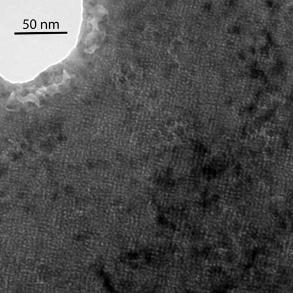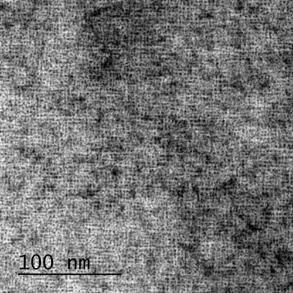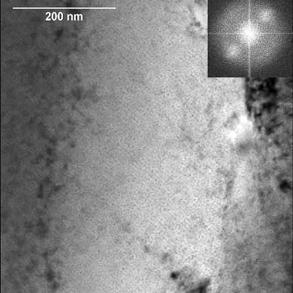Bubble superlattices were first discovered in the 1970s when helium ions implanted into molybdenum forming an ordered array of nanosized bubbles. Since then, many bubble superlattices have been observed in a number of metals from aluminium to tungsten. These superlattices orientate themselves relative to the host material’s crystalline lattice. For example, in body-centred cubic (BCC) tungsten the bubble superlattice is also BCC and in hexagonal-close packed (HCP) Zircaloy-4™ the bubbles form planes of randomly ordered bubbles. However, the mechanism(s) by which bubble superlattices form is still not understood. There have been various hypothesised explanations, from elastic interaction between bubbles to the anisotropic diffusion of self-interstitial atoms. One major problem in understanding this phenomenon is that previous studies have been able only to analyse samples before or after bubble superlattice formation.
By ion irradiating in-situ within a transmission electron microscope at the Microscopes and Ion Accelerators for Materials Investigations (MIAMI) facility at the University of Huddersfield, it is possible to observe the formation of these superlattices in real-time at the nanoscale. Recently, the MIAMI facility has been used to produce inert gas bubble superlattices in a number of materials of various crystalline structures including: copper, iron, tungsten, zirconium and Zircaloy-4™. Using the MIAMI facility, it is possible to vary the parameters under which bubble superlattice form (host material, ion species and energy, temperature etc) and then observe in real-time leading to insights into the formation mechanisms of these unusual self-organising structures.
 TEM micrograph of FCC helium bubble superlattice in copper, Credit: The University of Huddersfield
TEM micrograph of FCC helium bubble superlattice in copper, Credit: The University of Huddersfield BCC bubble superlattice in tungsten
BCC bubble superlattice in tungsten HCP bubble superlattice in zirconium alloy
HCP bubble superlattice in zirconium alloyRecent Publications
S. Donnelly et al., “In-situ TEM studies of ion-irradiation induced bubble development and mechanical deformation in model nuclear materials,” MRS Proc., vol. 1645, p. mrsf13-1645-ee10-01, Feb. 2014.
A. M. Robinson et al., “The effect of temperature on bubble lattice formation in copper under in situ He ion irradiation,” Scr. Mater., vol. 131, pp. 108–111, 2017.
R. W. Harrison, G. Greaves, J. A. Hinks, and S. E. Donnelly, “Engineering self-organising helium bubble lattices in tungsten,” Sci. Rep., no. June, pp. 1–8, 2017.
M. A. Tunes, R. W. Harrison, G. Greaves, J. A. Hinks, and S. E. Donnelly, “Effect of He implantation on the microstructure of zircaloy-4 studied using in situ TEM,” J. Nucl. Mater., vol. 493, pp. 230–238, 2017.
